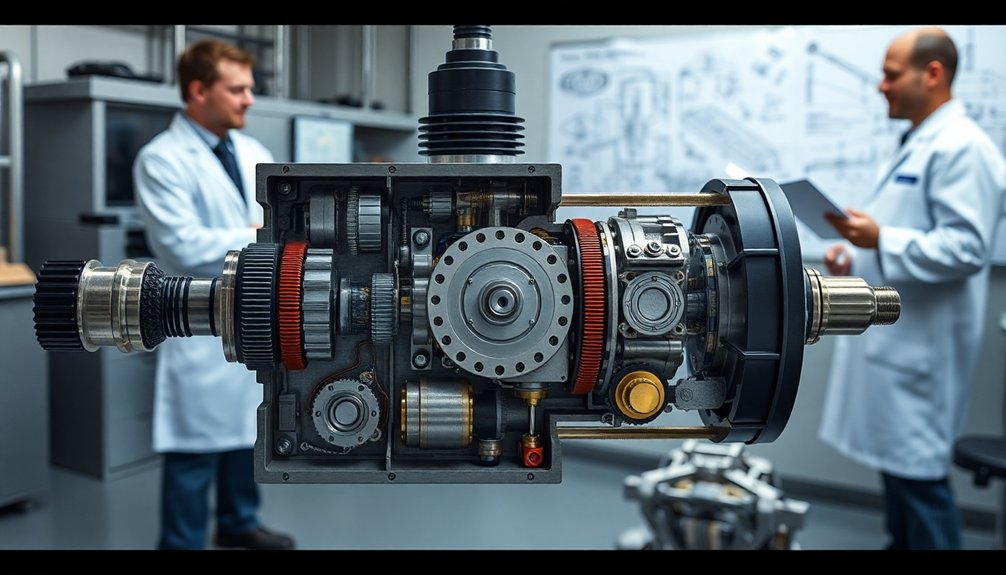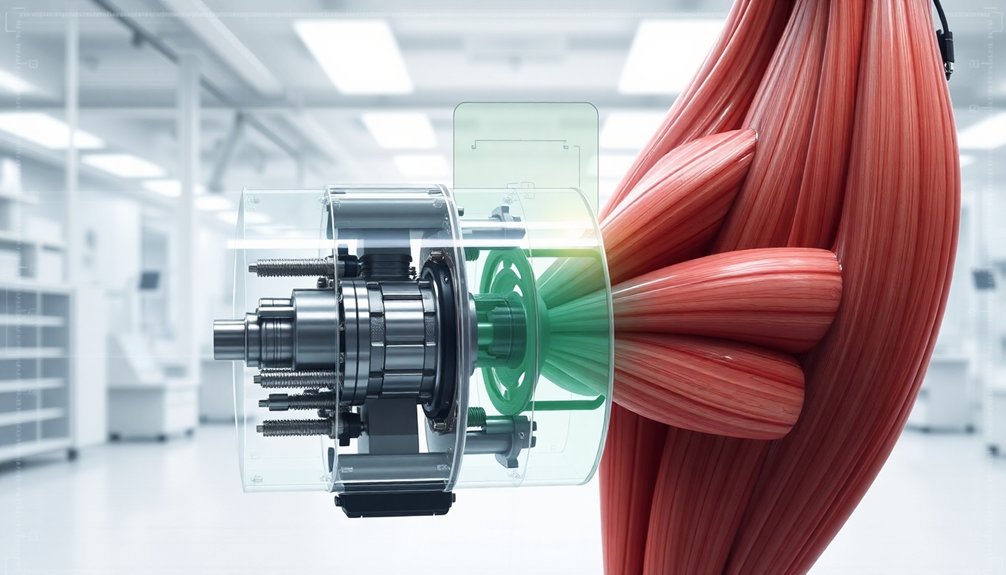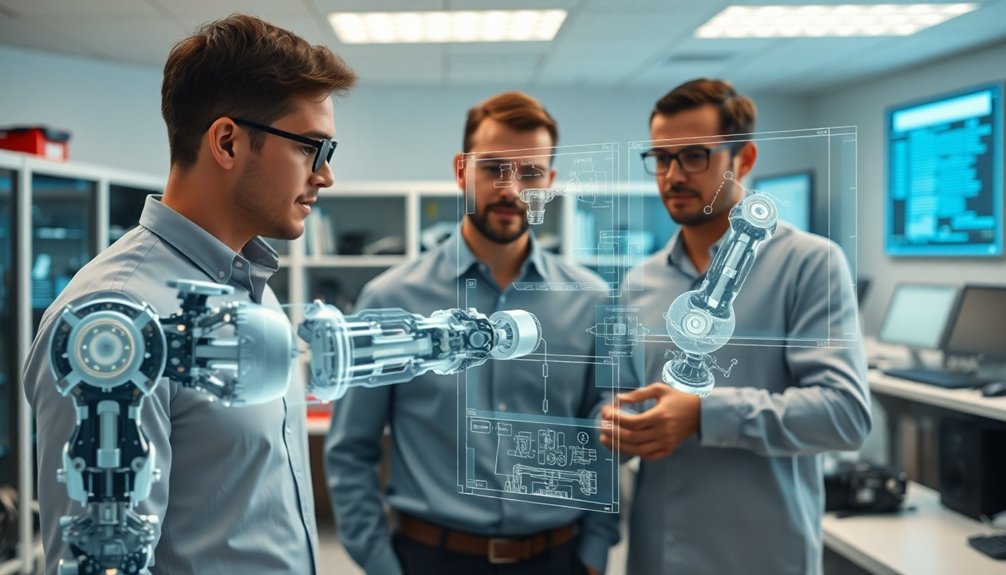Electromechanical actuators are your robot’s secret muscles—electrical wizards that transform energy into precise, powerful movements. Think of them as high-tech puppeteers turning electrical signals into dance moves, lifting power, and delicate gestures. Electric motors give surgical accuracy, while hydraulic systems pack serious strength. They’re what transform rigid machines into responsive, almost-alive beings that can pick up an egg or throw a punch. Curious about their robotic magic?
The Science Behind Electromechanical Actuators

While most people think of robots as mysterious mechanical beings, the secret sauce behind their movement lies in electromechanical actuators. These technological muscles transform electrical energy into precise movements that make humanoid robots dance, lift, and navigate complex spaces.
Think of them like robotic superpowers – electric motors spin robotic arms with surgical accuracy, while hydraulic actuators generate massive force for heavy-duty tasks. Ever wondered how a robotic arm can delicately pick up an egg without crushing it? That’s precision engineering at work.
Different actuator types – electric, hydraulic, pneumatic – each bring unique strengths to the table. They’re not just components; they’re the nervous system translating digital commands into physical actions. Cool, right?
Electromechanical actuators aren’t just making robots move – they’re redefining what machines can do. Bipedal robotic systems rely on these advanced actuators to replicate human-like movement and balance across various terrains.
Types of Actuators Used in Humanoid Robotics
Because robots aren’t just metal statues waiting to move, actuators are the secret sauce that transforms digital commands into physical motion. Advanced mechanical design in humanoid robotics leverages these sophisticated actuators to create more natural, human-like movement capabilities.
Humanoid robots rely on an impressive arsenal of actuators to mimic human-like movements:
Robotic actuators: the magical mechanisms transforming digital whispers into graceful, human-inspired mechanical dance.
- Electric actuators (like DC and servo motors) deliver precise movements, turning digital whispers into robotic choreography with lightning-fast accuracy.
- Hydraulic actuators pack serious muscle, enabling robots to handle heavy lifting and powerful tasks that would make mere mortals weak in the knees.
- Soft robotic actuators introduce flexibility and adaptability, letting robots bend, twist, and interact with environments without the rigid awkwardness of traditional machinery.
From pneumatic systems pushing compressed air to dielectric elastomer muscles mimicking human flexibility, these technological marvels are turning sci-fi robot dreams into tangible, moving reality.
How Actuators Simulate Human Muscle Movement

Robots aren’t just cold, mechanical contraptions anymore—they’re getting seriously good at moving like us humans. Soft actuators are revolutionizing how robotic muscles work, mimicking human muscle movement with mind-blowing precision. Tendon-driven systems enable robots to manipulate objects with unprecedented delicacy and control.
These soft robotics champions can stretch, contract, and perform tasks with an efficiency that’ll make your jaw drop. Imagine actuators that can grip, twist, and respond faster than you can blink—that’s the magic of modern robotic muscles.
They’re not just moving; they’re adapting, stiffening when fully extended and shifting gears like biological limbs. The coolest part? These energy-efficient robotic actuators are getting lighter, quicker, and smarter.
We’re talking about machines that can fundamentally do what your muscles do, but with superhuman consistency. Who said robots can’t be smooth operators?
Performance Characteristics and Design Challenges
When engineers plunge into electromechanical actuator design, they’re fundamentally wrestling with a high-stakes puzzle of physics and performance.
These robotic “muscles” demand serious innovation to overcome critical design challenges:
- Weight Reduction: Shrinking actuators without sacrificing force output means less bulk and more agility for humanoid systems.
- Energy Efficiency: Maximizing performance while minimizing power consumption is the holy grail of precise control and movement.
- Activation Speed: Rapid response times determine how lifelike and responsive robotic mechanisms can become.
Elysium Robotics’ dielectric elastomer actuators showcase this engineering dance, delivering 50% weight reduction and 40% efficiency.
They’ve fundamentally cracked part of the code, proving that electromechanical actuators aren’t just theoretical – they’re the future of robotic mobility.
Who wouldn’t want muscles that work smarter, not harder? Humanoid robot companions are increasingly relying on advanced actuator technologies to achieve more natural and responsive movements, as highlighted in emerging robotics research.
Future Innovations in Robotic Actuation Technologies

As engineers push beyond current electromechanical limitations, the next frontier of robotic actuation looks less like cold metal machinery and more like living, breathing muscle.
Soft robotic actuators are rewriting the rules, with dielectric elastomers mimicking human muscle performance while delivering jaw-dropping energy efficiency. These advanced actuators aren’t just moving parts—they’re smart materials that sense, adapt, and respond with precision previously unimaginable.
Imagine piezoelectric components delivering lightning-fast movements or shape-memory alloys that recover form like biological tissue.
Computational optimization is turbocharging torque transmission, allowing compact designs to generate massive force. The result? Multifunctional robotic applications that blur the line between machine and organism.
Who said robots can’t have soul?
People Also Ask About Robots
What Are the Actuators in Humanoid Robots?
You’ll find humanoid robots’ actuators are their muscles, converting energy into movement through electric motors, hydraulic systems, and soft robotic technologies like dielectric elastomer actuators, enabling complex, precise, and human-like motions.
Are Actuators the Muscles of Robots?
Powerfully propelling robotic parts, you’ll find actuators are indeed the muscles of machines. They’re mechanical marvels that convert energy into movement, enabling robots to perform tasks with precision and dynamic control.
What Are the Actuators in Mobile Robots?
You’ll find mobile robots use electric, hydraulic, and pneumatic actuators, each offering unique capabilities. They’re like robotic muscles, enabling precise movements through motors, pressurized fluids, and compressed air for various operational tasks.
What Are the Different Types of Actuators Used in Robotics?
You’ll find electric, hydraulic, and pneumatic actuators in robotics. Each type offers unique capabilities: electric motors provide precision, hydraulic systems deliver high force, and pneumatic actuators guarantee lightweight, reliable motion for various robotic applications.
Why This Matters in Robotics
Just like muscles transform our thoughts into movement, actuators breathe life into robotic limbs. They’re the hidden heroes turning electrical signals into precise, dynamic motion. You’ve seen the future: machines that don’t just compute, but move with almost human grace. Will they replace us or complement us? The dance between human engineering and mechanical evolution continues, one electrifying impulse at a time.
